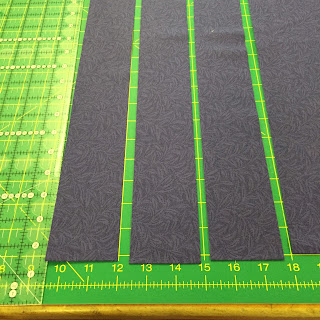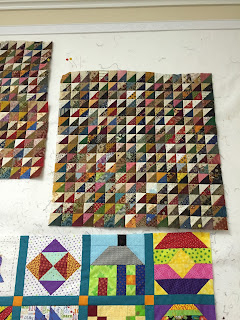There are only 3 things you can do "wrong" to make your piecing less than perfect: the cutting, the sewing, and/or the pressing. We will look at each of these skills so you can master them all and create beautiful quilts you will be proud of. NOTE: this post is photo-heavy and lengthy--it is a class in cutting!
 |
| 8 points coming together nicely |
 |
| A bit off--one of the points is "hidden" |
 |
| 3" block, pretty precise |
 |
| One more set of 3" blocks |
I am hoping you are after precise piecing, intersections that intersect, points that are sharp. Now, having said this, you should know that I describe myself as a
"95% quilter"--close is good enough most of the time. If you are planning to enter international competition, that is NOT good enough. If you are making quilts for people you love, it is fine AND you get to decide how precise it has to be. I started 30 years ago as a
"50% quilter" and was happy with that. You will get better the more quilts you make.
One more DISCLAIMER: I am not the quilt police and there is more than one way to complete any task. I will show you what works for me and what has worked very well for the more than 1000 beginning quiltmaking students I have taught over the years. If you have a different method that works well for you, I am happy for you and encourage you to keep at it. That is why there is chocolate AND vanilla--you get to choose. If you want some tips on how to improve, keep reading...
It starts with the cutting and that is where beginners seem to have trouble. Rotary cutting changed EVERYTHING in quilting and is one of the primary reasons our industry has grown so much in the last 40 years. Blades are sharp, rulers are abundant, and you need to learn how to use them. My shots are for right-handed people. Left-handed people can make great quilts--they just do everything upside down and backwards.
I prefer to cut only two layers at a time and use a 45 mm blade for this. (Olfa is my favorite brand for their sharp blades and ease of use.) When I cut four layers, I use a 60 mm blade--not often but occasionally. My favorite rulers are Creative Grids and Omnigrip--my students get instantly better when they switch to these--the built-in grippers on the underside of the rulers minimize slipping.
Here I have carefully pressed yardage to cut 2.5" binding strips. You can see the edges are not even so they need to be trimmed. Right handed people want their fabric on the right, ruler on the left. NOTE: I do not use the lines of the mat for anything--I only use the lines on the ruler for measuring.
Using two rulers, one a small square, and one a 24.5" long ruler, you will clean up that outside edge. Place a line from the square ruler on the bottom edge of the fabric--that is the folded edge, the selvages are at the top. Take care to press that folded edge neatly, eliminating any folds or puckers there. You want the fold on the straight of grain as much as possible.
Butt the long ruler up to the square, holding the square firmly in place so it stays on the fold line.
Now you can remove the small square and hold firmly to the long ruler as you make that first long cut. I find with Creative Grid rulers I can hold firmly in the middle and cut the entire 22-23" length without moving my hand. It takes a firm grip and shoulder pressure to keep the ruler from moving. Beginners find it helpful to cut about half-way up, placing their hand at no more than the 12" mark, then VERY CAREFULLY move their hand up toward the top of the ruler, again being sure it does not move out of place. If it does, place the small square back on the foldline and start over.
Now that the first cut is made and the long edge is perfectly straight, I place the ruler at the 7.5" mark. WHY? Because I am cutting my binding strips 2.5" wide and with my 8.5" wide ruler I can cut 3 strips under the ruler before I have to set it again. Here is the
IMPORTANT POINT:
You want the edge of the fabric to split the measuring line in half--it is hard to see as this line is black and the fabric is deep purple. So let's try another fabric and ruler:
The yellow fabric splits the black line exactly in half. If you can see the green mat to the right of the black line, it is too narrow. If you can see the yellow fabric to the left of the black line, it is too wide. You have to place the ruler somewhere, you might as well place it exactly where it needs to go.
Back to my purple binding strips:
After cutting the first strip at the 7.5" line, I carefully slide the ruler to the 5" line. DO NOT pick up the ruler to move it, just gently slide it in place, being careful NOT to move the fabric. Now I make that long cut.
Finally, I slide the ruler over to the 2.5" mark, again placing it very precisely where it needs to be, then make that last cut.
Here you see the 3 strips that have been cut. I move them out the way and place the ruler at the 7.5" mark again. To be honest, I had not pressed more than the first 9" or so of fabric, so I took the fabric back to my pressing station and pressed another 20" or so. Then back at the cutting station, I cleaned up the outside edge again, using the small square and long ruler, and then continued to cut 2.5" strips, 3 at a time, until I had the 10 strips I need. (A binding tutorial will be coming up in the future.)
That is the basics of cutting long strips from the Width of Fabric (WOF). If you are using fat quarters, you can fold them in half to cut 22" strips crosswise grain or 18" strips lengthwise grain. That is a whole other topic for another time. If you only have to cut 1 strip, just place the long ruler at the line for the width you need to cut, no sliding necessary. The sliding method works well when the numbers are easy to calculate, like 2", 4" ,6", etc., or my 2.5", 5", 7.5". Once you get into numbers like 2.375" it becomes more difficult and is just as easy to simply cut one strip at a time,
Here is how I cut fabric pieces for a block:
Here I am using scrap fabric and I only need one 4" square so I don't cut an entire 4" strip. If I was making several of these blocks, I would cut the strip 4" and sub-cut into 4" squares.
 |
| The block has been rotated 180 degrees so I can clean up the other two edges |
There is only a little sliver of waste, but a perfectly cut 4" square.
Now to be honest, this little block I am making actually needs four 2" squares and each will have a pencil line drawn on the diagonal. I learned this neat-o trick about a year ago and pass it on to you: Cut one 4" square, draw two pencil lines on both diagonals and then carefully sub-cut the square in half on both directions:
Viola! You now have four 2" squares with the pencil lines already drawn! There is a big added bonus: if you are using a directional fabric, like a stripe, the lines are drawn so that the stripes will all go up and down in your block. I like wonky quilts, I love the fun and playful vibe they have, but in reality I am a symmetrical kind of girl and just have to have my stripes in line. Guess it's the Marine in me: left, right, left, right, all together now...
If you were to cut four separate 2" squares and then draw the pencil lines, you would need to draw two lines going vertically and two horizontally to the stripes if you wanted those lines to be lined up like I do. By cutting the four squares at once, with the pencil lines drawn, you get this already done, no thinking necessary.
ONE MORE THING: how to change your blade.
I am often asked by students how often to change their blade. My answer is simple; No one has ever changed a blade and then said "I could have gotten two more weeks out of that old blade". You change it when you get tired of the blade sticking and not cutting all the way through your fabric every time. A new blade makes you feel so good!
And here is how my brand gets changed correctly, yours may be different:
I laid out the pieces in the order I took them apart. Using a small piece of batting I carefully cleaned away the lint and dust and grime that gets on the various parts. Be careful when handling the blades, both old and new.
Once clean, I reassemble. With the black surface face up, I added one drop of sewing machine oil at the bottom of the black surface just above the word "safety cover". If you get too much oil on it, wipe a bit off with that small piece of batting you have. The blade goes on with the name "Olfa" facing you. If you can't see the name, you have the blade on upside down.
I love this brand of Sewing Machine Oil with its' long spout: Zoom Spout Oiler from Nifty Notions. I got it at my Bernina dealer. I keep it in the bag, even when I use it, so any extra drop of oil does not get where I don't want it.
Now here is the trick--how does that washer go back on? Just yesterday a very experienced, super award-winning quilter confessed on Facebook she can never remember. So I decided to add this to our little lesson on cutting. The washer goes on
CUP UP. See how the washer is sitting on the mat with the curvy part up? Like a cup, if it didn't have a big hole in the middle.
Just place it in the same orientation, cup up, and then reattach the screw, finger tight. Warning: don't have a man do this for you; they won't pay any attention to how they took it apart and their "finger tight" and yours is very different. It will take pliers to unscrew it because it's way too tight. Just tight enough that it won't come off and so the blade rolls easily across the mat and through fabric.
If you are still here, thanks for staying with me and if you find this helpful, please share it all over the world. Part 2 will be coming up on the next problem area: The Sewing.
Let's Quilt!
Barbara
























































